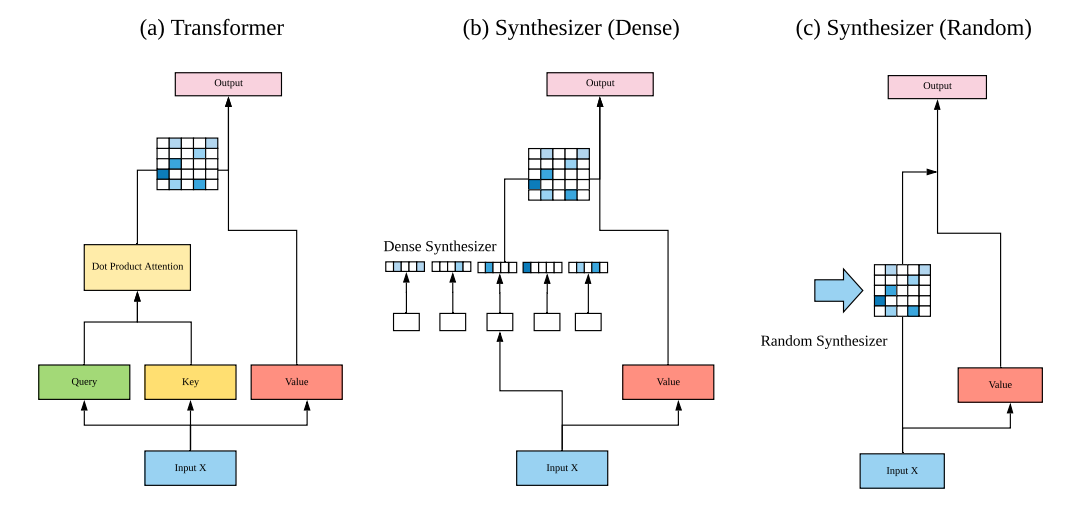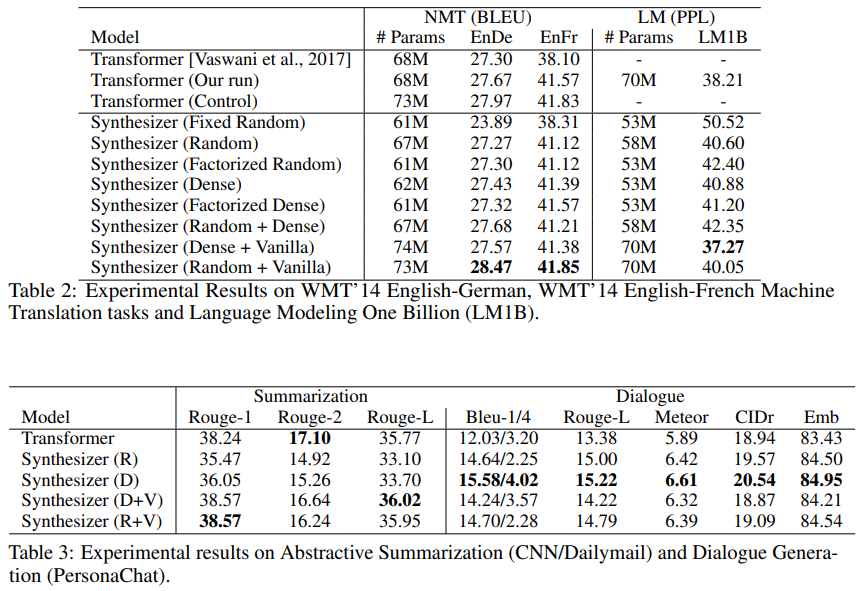Implementing SYNTHESIZER: Rethinking Self-Attention in Transformer Models using Pytorch
Reference
-
-
Author: Yi Tay, Dara Bahri, Donald Metzler, Da-Cheng Juan, Zhe Zhao, Che Zheng
-
Google Research
Method

1. Dense Synthesizer
2. Fixed Random Synthesizer
3. Random Synthesizer
4. Factorized Dense Synthesizer
5. Factorized Random Synthesizer
6. Mixture of Synthesizers
Usage
import torch
from synthesizer import Transformer, SynthesizerDense, SynthesizerRandom, FactorizedSynthesizerDense, FactorizedSynthesizerRandom, MixtureSynthesizers, get_n_params, calculate_flops
def main():
batch_size, channel_dim, sentence_length = 2, 1024, 32
x = torch.randn([batch_size, sentence_length, channel_dim])
vanilla = Transformer(channel_dim)
out, attention_map = vanilla(x)
print(out.size(), attention_map.size())
n_params, flops = get_n_params(vanilla), calculate_flops(vanilla.children())
print('vanilla, n_params: {}, flops: {}'.format(n_params, flops))
dense_synthesizer = SynthesizerDense(channel_dim, sentence_length)
out, attention_map = dense_synthesizer(x)
print(out.size(), attention_map.size())
n_params, flops = get_n_params(dense_synthesizer), calculate_flops(dense_synthesizer.children())
print('dense_synthesizer, n_params: {}, flops: {}'.format(n_params, flops))
random_synthesizer = SynthesizerRandom(channel_dim, sentence_length)
out, attention_map = random_synthesizer(x)
print(out.size(), attention_map.size())
n_params, flops = get_n_params(random_synthesizer), calculate_flops(random_synthesizer.children())
print('random_synthesizer, n_params: {}, flops: {}'.format(n_params, flops))
random_synthesizer_fix = SynthesizerRandom(channel_dim, sentence_length, fixed=True)
out, attention_map = random_synthesizer_fix(x)
print(out.size(), attention_map.size())
n_params, flops = get_n_params(random_synthesizer_fix), calculate_flops(random_synthesizer_fix.children())
print('random_synthesizer_fix, n_params: {}, flops: {}'.format(n_params, flops))
factorized_synthesizer_random = FactorizedSynthesizerRandom(channel_dim)
out, attention_map = factorized_synthesizer_random(x)
print(out.size(), attention_map.size())
n_params, flops = get_n_params(factorized_synthesizer_random), calculate_flops(
factorized_synthesizer_random.children())
print('factorized_synthesizer_random, n_params: {}, flops: {}'.format(n_params, flops))
factorized_synthesizer_dense = FactorizedSynthesizerDense(channel_dim, sentence_length)
out, attention_map = factorized_synthesizer_dense(x)
print(out.size(), attention_map.size())
n_params, flops = get_n_params(factorized_synthesizer_dense), calculate_flops(
factorized_synthesizer_dense.children())
print('factorized_synthesizer_dense, n_params: {}, flops: {}'.format(n_params, flops))
mixture_synthesizer = MixtureSynthesizers(channel_dim, sentence_length)
out, attention_map = mixture_synthesizer(x)
print(out.size(), attention_map.size())
n_params, flops = get_n_params(mixture_synthesizer), calculate_flops(mixture_synthesizer.children())
print('mixture_synthesizer, n_params: {}, flops: {}'.format(n_params, flops))
if __name__ == '__main__':
main()
Output
torch.Size([2, 32, 1024]) torch.Size([2, 32, 32])
vanilla, n_params: 3148800, flops: 3145729
torch.Size([2, 32, 1024]) torch.Size([2, 32, 32])
dense_synthesizer, n_params: 1083456, flops: 1082370
torch.Size([2, 32, 1024]) torch.Size([1, 32, 32])
random_synthesizer, n_params: 1050624, flops: 1048577
torch.Size([2, 32, 1024]) torch.Size([1, 32, 32])
random_synthesizer_fix, n_params: 1050624, flops: 1048577
torch.Size([2, 32, 1024]) torch.Size([2, 32, 32])
factorized_synthesizer_random, n_params: 1066000, flops: 1064961
torch.Size([2, 32, 1024]) torch.Size([2, 32, 32])
factorized_synthesizer_dense, n_params: 1061900, flops: 1060865
torch.Size([2, 32, 1024]) torch.Size([2, 32, 32])
mixture_synthesizer, n_params: 3149824, flops: 3145729
Paper Performance
